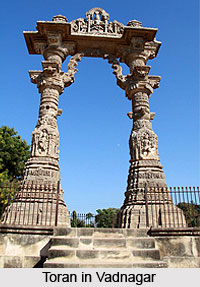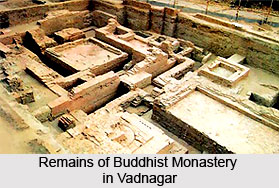 History of Vadnagar, in Mehsana district of Gujarat, dates back to more than 2500 years. The place is mentioned as Anartapur in the Hindu epic Mahabharata. It also mentions that the warriors of Anartapur fought in the war of Mahabharata on behalf of both sides and the rivalry among them continued even after the war. Historical facts also suggest that the place served as the earliest capital of Gujarat. However, after the war, the place lost its position as a capital city and the seat of power while a new city Vallabhi became the capital of Gujarat. Vadnagar continued to thrive as a trading city. Archaeological excavations at Vadnagar has proved that the place was a flourishing city around 1st century and was a hub of religious and cultural activities where patronized artists, dancers, musicians and sculptors emerged.
History of Vadnagar, in Mehsana district of Gujarat, dates back to more than 2500 years. The place is mentioned as Anartapur in the Hindu epic Mahabharata. It also mentions that the warriors of Anartapur fought in the war of Mahabharata on behalf of both sides and the rivalry among them continued even after the war. Historical facts also suggest that the place served as the earliest capital of Gujarat. However, after the war, the place lost its position as a capital city and the seat of power while a new city Vallabhi became the capital of Gujarat. Vadnagar continued to thrive as a trading city. Archaeological excavations at Vadnagar has proved that the place was a flourishing city around 1st century and was a hub of religious and cultural activities where patronized artists, dancers, musicians and sculptors emerged.
In 2nd century AD, the place came to be known as Ananadapura - `the City of Joy`. It also allured and sheltered various followers of Jainism and Buddhism. Gradually the city started to lose its prosperity due to its capture by the Malvas but continued being the centre of art and culture. From 942 - 1244, Vadnagar came under the rule of Solankis who disposed off the Malvas. The Solankis then built the fort around the town for protection. It was under this rule when the town reached the zenith of its prosperity and witnessed a number of architectural marvels including temples, kunds, residences, wells, torans etc.
 Vadnagar remained peaceful for the next four centuries after which it was attacked and destroyed by the army of Delhi Sultanate. Even after its devastation, the place managed to regain its prosperity but could maintain it only for a short span of time. In 1726, Vadnagar was attacked by Marathas and was practically burnt down to ashes leaving the place deserted. Again in 1735, it was looted by Khandji Holker and by Daqmaji Gaekwad in 1737 after which the city became completely ruined. Although Vadnagar has been the home to Nagar Brahmins since ages, it could not retain the community for long as they had to flee from the place owing to repeated attacks.
Vadnagar remained peaceful for the next four centuries after which it was attacked and destroyed by the army of Delhi Sultanate. Even after its devastation, the place managed to regain its prosperity but could maintain it only for a short span of time. In 1726, Vadnagar was attacked by Marathas and was practically burnt down to ashes leaving the place deserted. Again in 1735, it was looted by Khandji Holker and by Daqmaji Gaekwad in 1737 after which the city became completely ruined. Although Vadnagar has been the home to Nagar Brahmins since ages, it could not retain the community for long as they had to flee from the place owing to repeated attacks.
The main town is enclosed within the walls of a fort having six huge gates namely Amarthol, Pithori, Ghaskol, Nadiol, Arjun Bari and Amarthol. The gates were constructed by the Solanki king Kumarpal in 1152 A.D. These gates are intricately designed and represent the excellent craftsmanship of the bygone era. River Kapila flowed in the town in ancient past. A wondrous lake, known as Sharmistha Lake, having a beautiful island amidst it is present in this ancient town. Numerous temples and shrines also stand in Vadnagar, having their origin in remote past. The place was also a significant centre of Buddhism in the past and this fact has been established by the image of Bodhisattva, dating back to 3rd or 4th century AD, which has been found here. Evidences suggest that the image was brought from Mathura for installing in one of the Buddhist monasteries of the town.



















